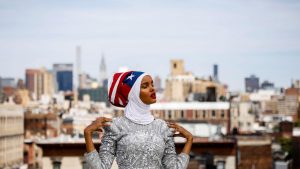Love fashion or hate it, there are three reasons to pay close attention to women’s clothing right now. So-called modest wear, ostensibly for Muslim women, is becoming a powerful political statement. In turn, it is tailoring corporate priorities.
Macy’s, one of America’s oldest and largest retail store chains, has introduced a “modest” fashion line aimed at Muslim women.
Sheikh Abdullah al-Mutlaq, a member of Saudi Arabia’s top clerical body, earlier said women should not be forced to wear the all-enveloping, regulation black abaya. It’s quite enough to dress modestly, he said.
Before that, a 22-year-old French Muslim singer likely on her way to superstardom quit a widely watched television competition after criticism of her views on extremist attacks. But Mennel Ibtissem’s politics may have been less eye-catching than her turbans, or headwraps, as a riveted European media described them.
They were in glorious colours — silvery grey, taupe, deep red and a sparkling blue pattern. The young trainee English teacher wore the head covering as she sang Leonard Cohen’s “Hallelujah” in English, French and Arabic, underlining a crucial point: It is entirely possible for a French-born-and-bred woman of Syrian-Turkish and Moroccan-Algerian ethnicity to embrace Western pop music and cover her hair.
There is no contradiction in the many layers of her manifest identity even though Ibtissem’s suspicion of the French government’s reporting of multiple terrorist attacks appeared to signify a dispiriting gulf between young French Muslims and the country they call home.
At this point, the politics of women’s clothes intersects deeply with the economics of fashion. Macy’s has been derided for “aiding and abetting abuse” by selling the hijab in America. Angry social media users described the headgear as a symbol of “male domination and subjugation of women.” One tweet said: “While women in Middle Eastern countries are risking their lives to take the #hijab off, Macy’s wants women in #America to put it on.”
The retailer’s new clothing line is no more than a canny — if delayed — business strategy. The 2015–16 “State of the Global Islamic Economy Report” states that approximately $230 billion is spent on clothing. By 2019, that’s projected to rise to $327 billion, which is about the combined current spending on fashion by the United Kingdom, Germany and India.
Unsurprisingly, brands at either end of the spectrum — high-end as well as affordable — are trying to cater to booming demand. There are denim hijabs from American Eagle and Japanese casual
wear retailer Uniqlo; Dolce & Gabbana luxury abayas; burkinis from Marks & Spencer and UK department store House of Fraser; and DKNY, Zara and Mango’s Ramadan collections.
Racks and racks of dressy flowing garments from small design houses are increasingly on offer. These serve as modest, fashionable and, sometimes, as practical options for women of different religious backgrounds — Muslim, Jewish, Catholic, Hindu, the Amish in America — or none.
In 2011, the well-known British television chef Nigella Lawson was photographed in a burkini on a Sydney beach. Years later, she explained that her former husband didn’t want her to get a tan and the head-to-toe garment provided excellent protection from the sun.
In many ways then, the rise of modest wear should not be seen solely as a Muslim style statement. It provides another option in a consumerist world. There’s nothing inherently Muslim anyway about high-neck tunics, flowing jumpsuits and ankle-length cardigans. One does not have to be Muslim to seek the freedom not to bare.
It wasn’t too long ago that battles over the burkini were raging in France, with several towns banning the garment as “incompatible” with French values.
There is an inevitable political subtext when hijabs (and burkinis) become overly visible in public spaces in the West. These garments are often viewed, in the words of a former French prime minister, as part of a “political project” but surely that is an overly provocative response to the impulse to dress modestly.
Despite politicians’ fulminations, economics may have the last say. Modest fashion is here to stay. The burkini wars really are over or, if they aren’t, they should be.


